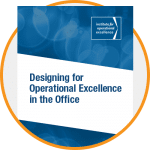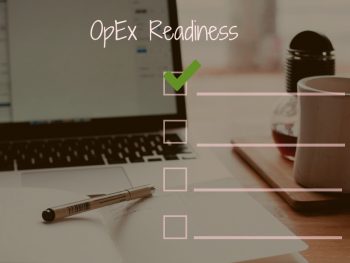In today’s business world, meetings practically define the workday, whether in person or via phone or video. And they’re continuing to increase in frequency and duration. In fact, research shows that executives now spend up to 23 hours a week in meetings, according to the Harvard Business Review. The problem with most of these meetings? They’re focused on putting out fires rather than business growth.
There’s a better way to run an office: let it run itself. And that’s precisely the goal of Operational Excellence.
OpEx in the Office
Improvement in the office is unique from manufacturing environments because unlike the shop floor, where inventory moves through the factory, it is hard to see information moving. So the approach to achieve Operational Excellence in the office is also different.
To design how information will flow from when a request for a service is received through all of the activities required to process the request and deliver the service to the customer, principles and guidelines are used to design value stream flow. By following these, the office will set a predictable cadence for moving information between people, departments, suppliers, or customers.
The eight principles of Operational Excellence, to be applied in order are:
- Design lean value streams
- Make lean value streams flow
- Make flow visual
- Create standard work for flow
- Make abnormal flow visual
- Create standard work for abnormal flow
- Have employees in the flow improve the flow
- Perform offense activities
Lean Value Streams for Business Processes
Within the first principle of OpEx—design lean value streams—there are specific guidelines for office flow that are crucial to the success of any transformation. They are:
- Takt and takt capability, which means setting a capability of what can be done in terms of mix and volume
- Continuous flow, or completing one activity and moving the work on to the next process in the flow, without stoppage or interruption
- FIFO, which preserves the sequence of work by eliminating the shuffling and reprioritizing of work at each process and creates predictability around when each job will be completed
- Workflow cycles, which refer to the rate at which work moves or flows within or between different work areas or departments along a fixed pathway
- Integration events that are used to hand off a large amount of work from one area of the company to another area or to an outside service
- Standard work, which ensures that flow in the office is repeatable and predictable, no matter who performs the work
- Single-point initialization, the single point within the value stream at which work is introduced
- Pitch, which is a tool that allows anyone to easily see if flow is operating normally without having to interrupt or ask questions
- Changes in demand that may require different takt capabilities
Meeting-Free Environments
When flow is designed by following these principles and guidelines, what results is an office where information flows from activity to activity along fixed pathways at preset, predefined times. That means instead of employees deciding on their own what to work on next or looking to phone calls, emails, meetings, task lists, or what the boss says, they know what to do from the designed flow. They will also know where they will get their work from, when to expect the information they need, when to send their completed work to the next activity and how the service or information will ultimately be delivered to the customer.
By creating flow in this way, which is considered normal, abnormal flow—when something begins to go wrong with the delivery of the service—is also defined. With visuals in place that tell if flow is normal or abnormal, employees will know how to recognize when abnormal conditions have occurred. By teaching them standard work for both normal and abnormal flow, employees know what needs to be done to correct abnormal conditions all on their own.
That means management will not need to intervene and hold meetings with other mangers to make decisions on what to do to fix problems, make priority changes, or share status updates. Instead, the office will run autonomously, delivering the service day in and day out by self-correcting when abnormalities occur. And the only meetings that will be held are those focused on business growth – talking with customers about their future needs, working with other divisions to plan strategy and so on.
Maintaining a Culture of OpEx
Despite OpEx’s end goal of business growth, lean initiatives in the office can easily plateau because of abnormalities. Things will go differently than planned, such as when customer demand becomes erratic or work takes longer than expected. But when these real-life conditions occur, management doesn’t have to be alerted and hold a meeting to put together an action plan. By achieving OpEx in the office, employees can act quickly to correct the issues so the flow works seamlessly each day.
While this refreshing approach can generate buy-in initially, maintaining a culture that continually backs the efforts can be more challenging. The key is to embed OpEx in the workplace so that the office will continue to follow and improve upon the designed flow for optimal results. And central to making that happen is education.
When everyone knows how the system is designed and why, it will build momentum. That’s because employees will see that there are visuals in place to show their team’s condition. They will all understand standard work for abnormal flow. And they will be on time to the plan and commitments, which eliminates backlogs – and meetings to address them. When employees realize these changes in their work environment, and know that they’re valuable in continuing to improve the office, they’ll be motivated to embrace OpEx in the short and long term.






